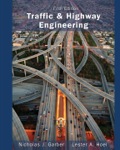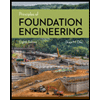
Traffic and Highway Engineering
5th Edition
ISBN: 9781305156241
Author: Garber, Nicholas J.
Publisher: Cengage Learning
expand_more
expand_more
format_list_bulleted
Question
Chapter 16, Problem 7P
To determine
The rate of runoff for a storm of 100-year frequency and average velocityfor 196-acre rural drainage area.
Expert Solution & Answer
Want to see the full answer?
Check out a sample textbook solution
Students have asked these similar questions
Problem 4
A propped cantilever beam of flexural rigidity EI and 2EI for parts 1-2 and 2-3, respectively, is
subjected to a concentrated load P at point 2.
Find:
a) Determine the displacement at point 2;
b) Determine the rotation at point 3;
c) Determine the reaction force and moment at point 1;
d) Determine the reaction force at point 3.
El
2
P
2 EI
2 L
Problem 3
15
A W150 x 37 rolled-steel beam is used below. Let P150 kN, L-10 m and E 200 GPa. Find
the deflection and slope at each node and each pin or wall reaction. If a software program such
Maple or MATLAB issued as part of the solution, a hard copy of the code must be submitted too.
1/2
1/2
1. Determine the bearings, azimuths, and lengths of lines AB, BC, CD, and DA for the closed loop
traverse data shown below in Table 1. Show calculations.
Table 1
Station
Northing [ft]
Easting [ft]
A
1,000
1,000
B
750
1,750
C
1,345
2,255
D
1,567
1,345
2. Compute the bearings of sides BC and CD in Figure 1. Show all work for all angles.
A
B
70°10'
S72°39'W
C
94°35'
Figure 1
Tt
(+)
B
D
Chapter 16 Solutions
Traffic and Highway Engineering
Knowledge Booster
Similar questions
- hoph - AT 10x AT 10.076 ht 0.076 0 0-1846112 14884 xh T 1.632m h-4- (1-22) h = 1.022m 14. The 4-ft-diameter cylinder, 4 ft long, is acted upon by water on the left and oil of sp gr 0.800 on the right. Determine (a) the normal force at B if the cylinder weighs 4000 lb and (b) the horizontal force due to oil and water if the oil level drops 1 ft. Solution Water Oil Barrow_forward3. The following data was collected for the traverse shown in Figure 2. a. Determine the latitudes and departures for all sides. b. Determine the linear error of closure and the accuracy ratio. C. Correct and balance the latitudes and departures. A N80°27'E 467.81 ft 497.50 ft N56°46' W B S34°51'E 483.69 ft 325.06 ft D N81°48' Warrow_forwardPlease answer the questions in the picture. Thank you for your help!arrow_forward
- 1500 N A B 3500 N/m 1.2 m 3.6 m 1.2 m 1800 N Beam Cross-section: 4b T D b 25 mm 100 mm For beam ABCD with cross-section shown, design the beam by determining the following: Draw the shear and bending moment diagrams (show your detailed computations to get credit) The minimum dimension for b [mm], knowing that the allowable flexural stress and transverse shear stress are 10 MPa and 0.5 MPa, respectively.arrow_forwardCivil engineering quantiarrow_forwardPlease answer the questions in the picture. Thank you for your help. For part B use the Second Picture.arrow_forward
- Derive by deconvolution the six-hour unit hydrograph from the following data for a watershed having a drainage area of 216 km2 , assuming a constant rainfall abstraction rate and a constant baseflow of 20 m3 /s. Six-hour period 1 2 3 4 5 6 7 8 9 10 11 Rainfall (cm) 1.5 3.5 2.5 1.5 Streamflow (m3 /s) 26 71 174 226 173 99 49 33 26 22 21 Use the unit hydrograph developed to calculate the streamflow hydrographfrom a 12 hour-duration storm having 2 cm of rainfall excess in the first six hours and 3 cm inthe second six hours. Assume a constant baseflow rate of 30 m3/s.arrow_forwardPlease answer the following question in the picture. Thank you for your help.arrow_forwardGiven the unit hydrographic in the table, calculate the streamdlow hydrographic from a 12 hour duration story having 2cm of rainfall excess in the first six hours and 3cm in the second six hours. Assume a constant base flow rate of 30 m3/sarrow_forward
- Based on the following information, what is the owner’s equity? Current Assets: $162,000Current Liabilities: $91,000 Fixed Assets: $290,000 long-Term Debt: $140,000arrow_forwardPlease refer to the below figure. Use f y = 60,000 psi and f c′ = 3000 psi. Each web is reinforced with 2-#4 rebars in one layer. (a) Use the entire flange width as effective. Determine if the interior Double-Tee beam behaves as a T-beam or rectangular beam. (b) Determine the design moment strength of the section. Hint: You can collapse the two webs in a single web as discussed in class.arrow_forwardGrade is being established to the bottom of a footing that is 24” thick. The elevation of thetop of the footing is 102.33’. the elevation of the existing grade is 106.14’. the backsight of thesurveying instrument on a benchmark of 100.00’ is 6.78’. what is the correct reading for the rodat the bottom of the footing?arrow_forward
arrow_back_ios
SEE MORE QUESTIONS
arrow_forward_ios
Recommended textbooks for you
 Traffic and Highway EngineeringCivil EngineeringISBN:9781305156241Author:Garber, Nicholas J.Publisher:Cengage Learning
Traffic and Highway EngineeringCivil EngineeringISBN:9781305156241Author:Garber, Nicholas J.Publisher:Cengage Learning Principles of Geotechnical Engineering (MindTap C...Civil EngineeringISBN:9781305970939Author:Braja M. Das, Khaled SobhanPublisher:Cengage Learning
Principles of Geotechnical Engineering (MindTap C...Civil EngineeringISBN:9781305970939Author:Braja M. Das, Khaled SobhanPublisher:Cengage Learning Fundamentals of Geotechnical Engineering (MindTap...Civil EngineeringISBN:9781305635180Author:Braja M. Das, Nagaratnam SivakuganPublisher:Cengage Learning
Fundamentals of Geotechnical Engineering (MindTap...Civil EngineeringISBN:9781305635180Author:Braja M. Das, Nagaratnam SivakuganPublisher:Cengage Learning Principles of Foundation Engineering (MindTap Cou...Civil EngineeringISBN:9781337705028Author:Braja M. Das, Nagaratnam SivakuganPublisher:Cengage Learning
Principles of Foundation Engineering (MindTap Cou...Civil EngineeringISBN:9781337705028Author:Braja M. Das, Nagaratnam SivakuganPublisher:Cengage Learning Principles of Foundation Engineering (MindTap Cou...Civil EngineeringISBN:9781305081550Author:Braja M. DasPublisher:Cengage Learning
Principles of Foundation Engineering (MindTap Cou...Civil EngineeringISBN:9781305081550Author:Braja M. DasPublisher:Cengage Learning

Traffic and Highway Engineering
Civil Engineering
ISBN:9781305156241
Author:Garber, Nicholas J.
Publisher:Cengage Learning

Principles of Geotechnical Engineering (MindTap C...
Civil Engineering
ISBN:9781305970939
Author:Braja M. Das, Khaled Sobhan
Publisher:Cengage Learning

Fundamentals of Geotechnical Engineering (MindTap...
Civil Engineering
ISBN:9781305635180
Author:Braja M. Das, Nagaratnam Sivakugan
Publisher:Cengage Learning

Principles of Foundation Engineering (MindTap Cou...
Civil Engineering
ISBN:9781337705028
Author:Braja M. Das, Nagaratnam Sivakugan
Publisher:Cengage Learning

Principles of Foundation Engineering (MindTap Cou...
Civil Engineering
ISBN:9781305081550
Author:Braja M. Das
Publisher:Cengage Learning
